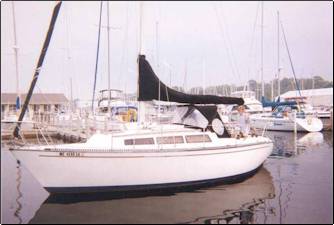Reviewed by Peter H. Vanderwaart
I went off for a week's vacation with this book in my suitcase. I read it
cover to cover, and I learned a fair amount. It contains tables and
methods not included in any of my other design books. The chapters include
styling, interior arrangement, materials, weights, hull lines,
calculations, engines, sail plans, and more. I suspect that a clever
person who knows what a good boat looks like could use the information in
this book to design a substantial vessel.
|

The Allied Mistress
|
Unfortunately, the writing is a little dull, the editing very poor,
and the proof-reading apparently non-existent. The appeal of this book is
greatly reduced by errors and omissions that I blame on the publisher,
especially bad layout of equations and tables. There are many minor errors
that should have been corrected in editing and proof-reading.
I also found that the inclusion of metric units was done in an
intrusive and ugly way. Each time a measurement is cited, it appears in
English units, with the metric following in parenthesis, thoughtlessly
converted. For example, "It is usual practice to have a 24 inch (.61 m)
wide passageway near the boat's centerline..." Surely the practical metric
counterpart to 24 inches is 0.6 meters in this context. The extra
centimeter is silly.
|

The Allied Princess
|
Here's a little more of the good and the bad.
Good news: The author, Arthur Edmunds, is a fine designer with much
experience. His explanations are clear and straightforward for the most
part. (There was just one that I couldn't make out after a couple
readings. It had to do with calculating the strength of frames in way of
the keel.) The drawings are appropriate and helpful.
Incidentally, the book does not give many examples of the author's
work. He mentions the Allied Mistress as the first fiberglass cruiser with
a "walk-thru" to the aft cabin, but only as an example of the variety of
types that a professional designed may be called upon to produce. The
other examples pictured here are ones that I have become aware of over the
past several years as I became interested in his work. I'm impressed by
his ability to get a traditional look with the Allied boats, and also
adapt the more modern appearance of the S2's.
|

The S2 8.5 |
Bad news: Edmunds is not a gifted writer. The writing, though clear,
is dull and a bit clunky in places, especially the introductory and
summary paragraphs of each chapter. Neither is he a great draftsman. His
drawings lack the crispness of Bolger, the style of Tanton, the polish of
Brewer. His lettering would not be admired by a high school mechanical
drawing teacher, and many of the illustrations have amateurish typed
labels.
Good news: the calculation of scantlings is treated in detail, both
with formulas and with a large number of rules of thumb. Altogether they
add up to a nearly complete scantling rule, and form the backbone of the
book. Methods are given for determining planking thickness, dimension and
spacing of frames and longitudinals, deck structures, masts, etc.
|

The S2 8.0 |
Bad news: the book focuses on fiberglass, steel and aluminum
construction. Wood is mentioned only in passing, and there is almost no
mention of plywood construction. Materials constants (yield strength,
flexural modulus) are given for the favored materials but omitted for
plywood. I find it odd for the amateur's favorite to be ignored in a book
aimed at amateurs. It should be possible to research the needed constants
for plywood and work through the formulas.
In summary, this book fits in a niche between the accessible but
skimpy "How To Design A Boat" by John Teale, and the scientific but
prohibitively mathematical "Principles of Yacht Design" by Lars Larsson
and Rolf E. Eliasson. I expect to get a lot of use out of it, fuming at
the editors the whole time. |